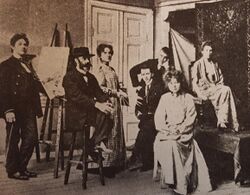Philosophy:Konstnärsförbundets skola
Konstnärsförbundets skola was a painting school in Stockholm, Sweden, which was offered by Konstnärsförbundet ('the Artists' Society') 1890–1908. The latter association was in turn established in opposition to the Royal Swedish Academy of Fine Arts. One of the school's co-founders was Richard Bergh. The school had several well-known teachers, including Anders Zorn, Nils Kreuger and Karl Nordström, in addition to Bergh himself. Several of the alumni would distinguish themselves on the contemporary Swedish visual arts scene. The group De unga, for example, consisted mainly of pupils from the school.
First school 1890–1896
In 1886, Konstnärsförbundets skola was formed due to dissatisfaction with the Royal Swedish Academy of Fine Arts. With this came a desire for an independent art school.[1] In Denmark there were already two art schools outside the academy, Krøyer's and Zahrtmann's schools. Konstnärsförbundet therefore decided to start teaching and Richard Bergh would be the one to lead it. As a teacher, he was considered generously oriented in his relations with the students, although according to Axel Erdmann, he "reasoned incomprehensibly learnedly about complementary colours and colour clashes that few conceive of...".[2] The school distinguished itself by letting the pupils take the initiative and teaching was done through a continuous discussion of their work. Pupils who felt they could afford it had to contribute to the cost of rent and heating.[3]
The first school in 1890–1896 was run by Bergh. Patrons such as Eva Bonnier, Prince Eugen, Pontus Fürstenberg and Ernest Thiel sponsored the school. A quarter of the pupils, ten in number, were women.
Teachers
- Richard Bergh
- Anders Zorn
- Per Hasselberg
Selected students
Second school 1899–1901
The school was run by Bergh and sponsored by Zorn, Fürstenberg and Messrs Lamm.
Selected students
Third school 1905–1908
The school was run by Bergh. Robert Thegerström made himself unpopular and was forced to resign as a teacher. Several of the students from this last group went on to form De unga and exhibited their work at Hallin's art shop in Stockholm in 1909. This is often regarded as the breakthrough of modernism in Swedish art. The last school had 31 men and nine women.[6]
Teachers
Students
Carl Kylberg (sv) was enrolled but fell ill a few days before the start of school.
References
- ↑ "Konstnärsförbundet | Historia | Eggers Hotell | Göteborg" (in sv-SE). https://www.hoteleggers.se/artiklar/konstnarsforbundet/.
- ↑ (in sv) Konsten 1890-1915. Jan Torsten Ahlstrand. Lund: Bokförlaget Signum. 2001. pp. 233. ISBN 91-87896-46-X. OCLC 48368276. https://www.worldcat.org/oclc/48368276.
- ↑ (in sv) Konsten i Sverige. D. 2, [Från 1800 till 1970.]. Sven Sandström. Stockholm: Norstedt. 1988. pp. 235. ISBN 91-1-883481-7. OCLC 186164751. https://www.worldcat.org/oclc/186164751.
- ↑ Steorn, Patrik. "Kerstin Maria (Maja) Fjæstad" (in sv). http://skbl.se/sv/artikel/MajaFjstad.
- ↑ Wallin Wictorin, Margareta. "Harriet Sundström" (in sv). http://skbl.se/sv/artikel/HarrietSundstrom0.
- ↑ "Konstnärsförbundet" (in sv). Nordisk familjebok: 14 Kikarsikte-Kroman. 1911. pp. 867–868. OCLC 246415390. https://runeberg.org/nfbn/0466.html.
- ↑ Flensburg, Birgitta. "Eva Henriette Jancke-Björk" (in sv). http://skbl.se/sv/artikel/EvaJanckeBjork.
- ↑ Artur, Lilja, Gösta Olsson, Bror Svensson, S. (1967) (in sv). Svenskt konstnärslexikon: tiotusen svenska konstnärers liv och verk. Allhem. OCLC 1163565182. http://worldcat.org/oclc/1163565182.
- ↑ "Arthur Percy" (in sv-SE). https://www.kalmarkonstmuseum.se/designarkivet/designers/arthur-percy/.
- ↑ Wallin Wictorin, Margareta. "Hanna (Anna) Maria Sahlström" (in sv). http://skbl.se/en/article/AnnaSahlstrom.
- Signums Svenska Konsthistoria, Bokförlaget Signum, ISBN:91-87896-46-X
- Sandström, Sven, Konsten i Sverige, Nordstedt, ISBN:91-1-883481-7
 |


